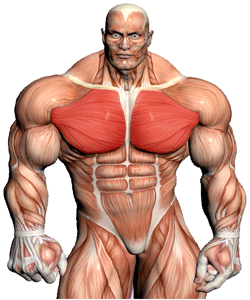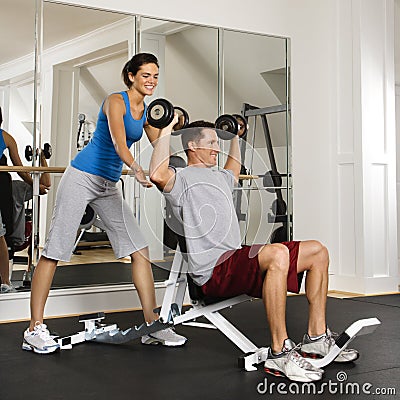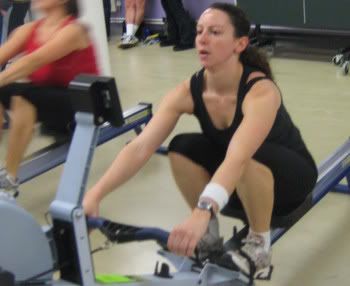 The dumbbell chest press closely mimics the bench press. This exercise works your chest muscles, along with your shoulders and triceps. You may want to modify or avoid this exercise if you have shoulder, elbow, or lower back problems.
The dumbbell chest press closely mimics the bench press. This exercise works your chest muscles, along with your shoulders and triceps. You may want to modify or avoid this exercise if you have shoulder, elbow, or lower back problems.Getting set
Lie on the bench with a dumbbell in each hand and your feet flat on the floor (or up on the bench if it’s more comfortable). Push the dumbbells up so your arms are directly over your shoulders and your palms face forward. Pull your abdominals in, but don’t jam your back into the bench; don’t let it arch way up, either. Tilt your chin toward your chest. See photo A. Lower the dumbbells down and a little to the side until your elbows are slightly below your shoulders. Push the weights back up, taking care not to lock your elbows or allow your shoulder blades to rise off the bench. See photo B.
Do’s and don’ts
- DO allow your lower back to keep its natural arch so you have a slight gap between your lower back and the bench.
- DON’T contort your body in an effort to lift the weight; lift only as much weight as you can handle while maintaining good form.
Other options
Partial dumbbell press (easier): Lower the weights only about three quarters the distance of the basic version of this exercise. Try this version if you have elbow, shoulder, or rotator cuff problems.
Incline chest press: Perform this exercise on an incline bench, and you use less weight than when you perform a flat-bench press. You’ll challenge the upper fibers of the pecs more.
Decline chest press: Do this exercise on a decline bench, with your head lower than your feet. The hardest part of this version is picking up and releasing the weights. Grab the weights while you’re sitting up, hold them against your chest, and ease yourself into the decline position. When you’re done with the exercise, gently ease the dumbbells off to either side to the floor. (Don’t just drop them.) Better yet, ask someone to hand the weights to you at the start of the exercise and take them away when you’re done.




 Experts argue this point, but let personal preference be your guide. Here are our recommendations:
Experts argue this point, but let personal preference be your guide. Here are our recommendations:





 Most lower back exercises — particularly those appropriate for beginners —don’t involve free weights or machines. Usually, it’s just you and the floor.
Most lower back exercises — particularly those appropriate for beginners —don’t involve free weights or machines. Usually, it’s just you and the floor.













 Most weight-training mistakes made don’t affect anyone but you. However, if you mess up while spotting someone else, you may be putting your friend (or soon-to-be ex-friend) at risk for injury. Or, at the very least, you may be depriving your buddy of an enjoyable and effective workout. When acting as a spotter, you need to walk that fine line between not helping enough and getting too involved.
Most weight-training mistakes made don’t affect anyone but you. However, if you mess up while spotting someone else, you may be putting your friend (or soon-to-be ex-friend) at risk for injury. Or, at the very least, you may be depriving your buddy of an enjoyable and effective workout. When acting as a spotter, you need to walk that fine line between not helping enough and getting too involved.
 If you sit hunched over in a chair most of the day, you’re a good candidate for goofing up the seated cable row.
If you sit hunched over in a chair most of the day, you’re a good candidate for goofing up the seated cable row.








